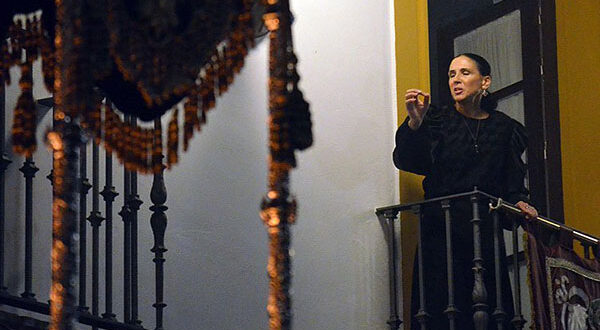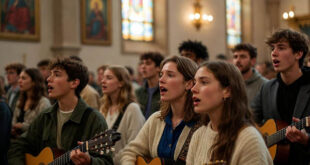Introduction: When the Street Becomes an Altar and the Voice, Incense
Amid the clamor of Andalusian Holy Week, between silences laden with emotion and the scent of incense rising through cobbled alleyways, a haunting voice emerges—deep, raw, alive. A voice not raised for art’s sake, but for faith; not projected for applause, but for Heaven. It is the saeta: a song launched like a burning arrow into the heart of the Crucified and His Sorrowful Mother.
The saeta is not just a cultural or folkloric expression. It is much more: a popular prayer, a plea made art, one of the purest expressions of the believing people, who sing to God with a broken voice from the street. And like all things born from the depths of the soul, it has survived centuries, wars, secularization, indifference… and still moves Heaven.
In this article, we will explore the saeta’s origin, its history, its transformation, and above all, its spiritual dimension, which makes it more than music: it becomes street mysticism, an improvised catechesis, a cry of the soul toward the Eternal.
I. What Is a Saeta? A Definition Too Deep for Dictionaries
The dictionary says a saeta is a “brief, fervent Andalusian religious song, sung without instrumental accompaniment, especially during Holy Week.” But that definition falls short—very short.
The word “saeta” comes from the Latin sagitta, meaning “arrow.” And that is exactly what it is: an arrow of love and sorrow shot toward Heaven. A plea that springs from the people’s heart and pierces the mystery of Christ’s suffering and His Mother’s sorrow.
Saetas do not follow rigid musical scores. They are born from the expectant silence as the procession passes. They are launched from balconies or even sidewalks. And there, without microphones or stage lights, the voice resounds—and stirs the soul. The saeta doesn’t entertain: it wounds. It isn’t sung: it is prayed.
II. Origins: From Monasteries to the Streets
Though many associate the saeta exclusively with flamenco, its origins are much older and deeply spiritual.
a) The Primitive Saeta: Prayer of the Franciscans
In the 16th century, Franciscan friars used a form of passionate, popular preaching in the form of brief sung litanies. These were short invocations to the Crucified or the Sorrowful Virgin, sung during devotional events, especially during the Stations of the Cross.
These early saetas were true exercises in public contemplation, a sort of sung homily that sought not musicality, but spiritual power. Their goal was to call people to conversion, to move hearts, to awaken compassion.
b) From the Monastery to the Street
Over time, this form of prayer moved from the monastic setting into the hands of the people. And there, in the deeply devout and expressive Andalusian soul, the saeta began to evolve.
It fused with oral tradition, with cante jondo, with the passion of flamenco, until it gave birth to what we now know as the flamenco saeta, an evolution that preserves the spirit but adds an aesthetic power that made it famous.
III. Types of Saetas: All Daughters of the Same Sorrow
There are different types of saetas, though all share that devotional and passionate character.
1. The Liturgical or Primitive Saeta
This is the oldest form: brief, solemn, more recited than sung, and deeply spiritual. It still survives in some areas of Andalusia (like Puente Genil or Lucena), and is closest to the conventual saetas of past centuries.
2. The Flamenco Saeta
Longer, with complex melodies, vocal ornamentation, and intense dramatism. It is derived from flamenco styles like the seguiriyas or tonás, and was adopted by great flamenco singers from the 19th century onward.
This is the most well-known form today. Though it has grown in technique, its power remains spiritual, especially when sung with true faith.
IV. The Saeta as Prayer: Theology Made Flesh
Why do we call the saeta a prayer? Isn’t it just a musical performance?
Because its content is profoundly Christological and Marian, and because it is performed as a plea, an act of love, a supplication that springs from the soul.
Let’s hear some traditional saetas:
“Who took you down from that cross / if not my sorrow? / Even my soul escapes me / to see you bleed, Mary.”
“Nailed for my sins, / Lord, you died for me. / And I go on sinning? / What a poor return I gave you!”
“Tears of a mother / who cannot be consoled. / If Heaven weeps with you, / who could not be torn apart?”
Each of these lines is a theological meditation. In few words, they speak of the mystery of Redemption, the pain of the Virgin, human sin, and the call to conversion.
But it’s not academic theology. It is lived theology, incarnated in the broken voice of the singer. It is the people making Christ’s Passion their own and weeping it from the heart.
V. Saetas Today: A Song of Spiritual Resistance
In an age of noise, superficiality, and loss of the sacred, the saeta rises as a prophetic resistance.
Because the saeta is not sung to entertain, nor sold as a show. It is spontaneous, often anonymous, freely given. It is a cry of love that asks for nothing in return—except that God listen.
And for that reason, it still plays a deeply relevant role today. Because the world needs beauty—but beauty that saves. It needs authenticity. And the saeta is both: redeeming beauty and naked authenticity.
When a singer raises a saeta from a balcony, they are not merely performing—they are proclaiming an eternal truth in a society that has forgotten it. They are making present, once again, the drama of Calvary in the streets of their neighborhood.
VI. And Us? What Can We Learn?
Maybe not all of us know how to sing. But we can all learn something from the saeta.
- First, that faith is not lived only in churches. It’s lived in the streets, in daily life, in balconies, in the people’s voice.
- Second, that prayer doesn’t need sophisticated formulas. A wounded heart that gazes upon the Crucified is enough.
- Third, that art, when united with faith, becomes a bridge to God. The saeta is a perfect example of this.
And above all, that Christ’s Passion is not just past—it is present. Every time a saeta is sung, Calvary is renewed, not as sterile pain, but as redemptive love still at work in our lives.
Conclusion: Arrows That Still Move Heaven
In a world rushing without looking up, the saeta stops—and aims its soul toward the sky. Amid the noise, it launches its silent cry like a burning arrow, reminding us that Christ still walks our streets, bearing our crosses.
The saeta will not die. Because as long as there is a heart that suffers, a mother that weeps, a sinner who repents, someone will sing to the Crucified with a trembling voice—and Heaven will shudder once more.
And you? To whom would you sing your saeta today? What cry do you need to launch to Heaven so God might hear it?
You may not need a melody. Just faith. And an open heart. Because sometimes, the most beautiful prayers are not spoken… they are sung.






